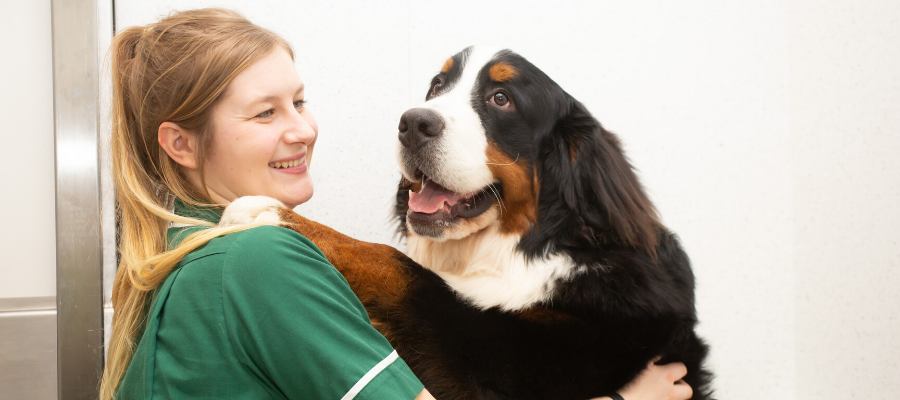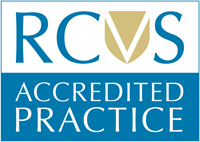What is the condition?
Canine GDV (gastric dilation and volvulus) or gastric bloat is a condition primarily of large, giant and deep-chested dogs. This condition occurs when the stomach becomes filled with gas, food, fluid or a combination (for example, food may cause the blockage then start fermenting, releasing gas) and becomes blocked. This makes the stomach dilate (expand) and put pressure on other organs. In most cases, although not all, the stomach will twist (volvulus). Blood flow to the organs involved become restricted, which can cause necrosis of the stomach wall and the other organs (often the spleen). GDV can trap blood in the stomach and prevent it from returning to the heart, leading to shock. It requires immediate treatment and most often surgical intervention for your dog to have a chance of surviving. If left untreated, it will most likely lead to shock and death. It is important that if you notice any of the symptoms of bloat, that you telephone your vet immediately – early intervention is directly correlated to survival.
It is not certain what causes GDV, making it difficult to prevent. There are risk factors which increase your pet’s likelihood of suffering from GDV:
- Vigorous exercise after a meal
- Fast eating – eating very quickly and taking in air at the same time
- Having a first degree relative (parent, sibling or child) who has suffered from GDV
- Nervousness or stress
- Age – older animals are more likely to suffer with a GDV
- Deep-chested breeds are predisposed as there is more room for gas-filled organs to move in the abdomen.
There are certain breeds which are more prone to GDV:
- German Shepherd
- Great Dane
- St Bernard
- English Setter
- Bernese Mountain Dog
- Irish setter
- Boxer
- Weimaraner
- Newfoundland
- Bassett Hound
- Standard Poodle
Symptoms
- Change in behaviour or restlessness
- Increased breathing rate and effort
- Weakness or collapse
- Unproductive retching (bringing up just white froth)
- Hard swollen belly
- Pale gums
- Excessive drooling
- Shock and death
When to contact the vet?
As soon as any of the symptoms above begin to show, call your veterinary practice straight away as this is an emergency.
Diagnosis
This condition is generally diagnosed with a clinical examination and an x-ray or scan of the abdomen to see if the stomach is dilated with gas or twisted. A blood test will also be carried out to examine organ function as they are at risk in GDV.
Treatment
Treatment varies depending on the severity of the GDV. If your dog was diagnosed with GDV, we would begin by giving intravenous fluid therapy (a drip) to treat shock caused by the condition. As the condition is very painful, immediate pain relief will also be administered.
Once they are under anaesthesia, we then will try and deflate the stomach by releasing some of the gas build up. This is done either by passing a stomach tube through your dog’s mouth into the stomach or, in severe cases where the tube will not pass, through placement of a needle through the body wall directly into the stomach.
Surgery will then be performed once they are stabilised. During the surgery the stomach is untwisted if it has become twisted, and emptied using a stomach tube. The empyting process can take quite some time – it is very important to make sure that any food in the stomach is completely removed, as remains of food can continue to ferment and cause a recurrance. Once this is complete, a gastropexy will then be performed, which aims to prevent recurrence of the condition in the future. This involves anchoring the stomach in the correct position, to the abdominal wall. Depending on the severity of the twist, occasionally part of the stomach or the spleen might need to be removed. In the event that a gastropexy cannot be performed – in some cases, the stomach emptying can take a significant amount of time and increase your dog’s anaesthetic risk, we will be recommend a laparoscopic gastropexy at a later date.
Your dog will require hospitalisation and close monitoring following surgery as there is a risk of complications. Once the vet is happy that your dog is out of danger, then they can go home.
Once home, monitoring needs to continue for signs of a second bloat, vomiting, not eating and lethargy. Your dog should not be exercised for 10 days post surgery and fed a bland, easily digestible diet in small quantities at a time – the vet will discuss this with you. Stitches will usually be removed 10-14 days post surgery but we will likely request several check ups in the interim.
Prevention
- Pay close attention to your dog’s diet, feeding and exercise.
- Avoid any vigorous exercise before or after a meal, allow for at least an hour either side.
- Avoid taking your dog in the car following a meal.
- Feed from the ground and not in a raised bowl or from a height.
- Slow down your dog’s eating with slow feeder bowls.
- Feed a mixture of wet and dry diet.
- If your dog drinks a lot in one go, try to encourage them to drink little and often and don’t leave a large amount of water down.
- Ensure you dog is not stressed or fearful
- Discuss with your vet whether a prophylactic gastropexy would be advised.
Call us on 01435 864422 if your dog is showing any symptoms of bloat.


